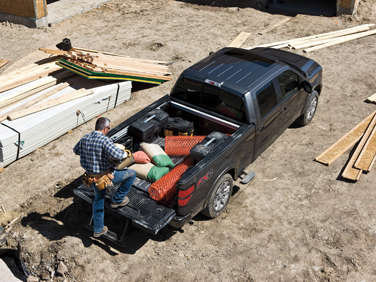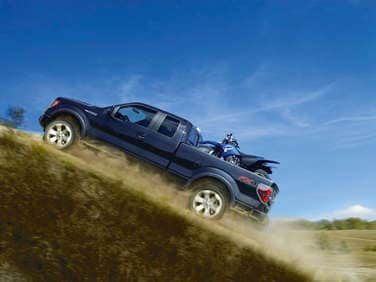Recent Articles
Popular Makes
Body Types
Ford F-150 EcoBoost Tops 100K Sales

Life sure was different back in 1985. Ronald Reagan was begining his second term as president of the United States, Coca-Cola introduced “New Coke,” the movie Back to the Future premiered, and researchers found the wreck of the Titanic (to name just a few of the year’s highlights). And 1985 also marked a notable milestone for Ford, as it was the last year the company sold at least 100,000 V6-powered pickups—until 2011, that is. Thanks to the success of the Ford F-150 EcoBoost, featuring an advanced 3.5-liter V6 engine, the Blue Oval has topped that mark yet again, utterly transforming the U.S. pickup market in the process.
Boosting Power, Efficiency and Sales
At this stage, some 40 percent of F-150 buyers are choosing EcoBoost powerplants, and with good reason. Combining powertrain technologies like gasoline direct injection and turbocharging, the EcoBoost engine offered in the 2012 F-150 makes 365 hp and 420 lb.-ft. of torque—not even the biggest light-duty V8s from Chevy or Ram offer more torque, and most rival eight-cylinder engines make less horsepower, too. As a result, the F-150 showcases the highest maximum tow rating (11,300 lbs.) and payload capability (3,060 lbs.) of any light-duty pickup on the road today. Yet at the same time, the EcoBoost V6 helps the F-150 score EPA ratings of 16 mpg city/22 mpg highway/18 mpg combined. That’s slightly better than the marks of the “high-efficiency” Chevy Silverado XFE V8, which earns ratings of 15/22/18, and significantly ahead of the HEMI Ram’s 14/20/16; the V8-equipped imports, the Toyota Tundra and Nissan Titan, can do no better than 15/20/17 and 13/18/15, respectively.
And not only does the EcoBoost V6 ring up better EPA ratings than any V8 rival, it also tops all the V6 competition and, when mated to Ford’s four-wheel-drive system, all other 4WD full-size pickups. The F-150 EcoBoost is capable of 21 mpg highway when all wheels are being driven, while no other non-hybrid V8 competitor can top 19 mpg in that measure.
It’s no surprise, then, to note the F-150 recently captured its fourth Motor Trend Truck of the Year honor and is well on its way to becoming the best-selling truck in the country for the 35th consecutive year, having surpassed the 500,000-sales mark back in November.

Success Breeds Success
Just as importantly for Ford, the impressive market reception for the F-150 EcoBoost has set the stage for similar success in other segments on the truck side of the business, particularly in some of the key crossover categories. Both the 2012 Ford Edge and Ford Explorer offer four-cylinder EcoBoost engines, for example, and both now carry top EPA ratings and growing sales momentum.
The Edge, kitted out with the automaker’s 2.0-liter EcoBoost I4, has been EPA certified to reach 21 mpg city/30 mpg highway/24 mpg combined—the highest ratings of any SUV of its size—while holstering 240 hp and 270 lb.-ft. of torque; to put those numbers into context, the Chevy Equinox V6 produces 48 fewer lb.-ft. of torque and can only attain EPA marks of 17/24/20, albeit with 264 horses under the hood.
As a result, the Edge racked up nearly 110,000 deliveries through the end of November and is on pace for its second-best sales year ever. The Explorer is doing even better, helped as well by an all-new design that launched earlier this year. Sales of the Explorer were up more than 140 percent heading into the final days of 2011, while its EPA ratings with Ford’s 2.0-liter EcoBoost were up to 20 mpg city/28 mpg highway/23 mpg combined. The last figure represents a combined rating that’s 9.5 percent better than the Honda Pilot’s and more than 21 percent ahead of the Jeep Grand Cherokee or Chevrolet Traverse.
Taking the Next Step
Ford also currently offers EcoBoost engines in the Ford Taurus SHO, Ford Flex, Lincoln MKS and Lincoln MKT, and the automaker expects to make the technology available on 90 percent of its lineup by 2013. Next up for a heart transplant: The all-new 2013 Ford Escape, which will offer a pair of EcoBoost I4 choices, one displacing 1.6 liters and the other 2.0 liters. Unsurprisingly, Ford is expecting the new EcoBoosted Escape to set new benchmarks for fuel-efficiency in its class when it launches in the first half of 2012, with EPA ratings up to 5 mpg better than the outgoing model.
Also set to debut next year is the first application of a four-cylinder EcoBoost engine in a high-performance model—The Focus ST, slated to launch later in 2012. Representing a reengineered version of the 2.0-liter unit found in the Edge and Explorer, the Focus ST’s EcoBoost I4 will receive upgraded intake and exhaust systems, along with a unique engine calibration specifically developed for use in Ford’s upcoming hot hatch.
With that mill residing within its engine bay, the Focus ST will benefit from 240 hp and 250 lb.-ft. of readily available torque, on tap across a wide power band.
“You get peak torque throughout the majority of the engine’s operating range,” explained Scott Makowski, Ford manager of North American four-cylinder powertrains. “It’s available when you accelerate from a stop or merge onto the Interstate, and drivers don’t have to wait for the rpm to build before they get exhilarating performance. There’s torque—and a lot of it—whenever you need it.”
In addition, Ford earlier this summer announced it would launch a 1.0-liter, three-cylinder EcoBoost powerplant that will be the smallest engine that company has ever produced. And although it’s destined to launch first overseas, the automaker has confirmed it would make its way into its U.S. lineup some time in the mid-term future.
Said Derrick Kuzak, Ford’s group vice president for Global Product Development: "With our global family of EcoBoost engines, we've replaced V8s with V6s and V6s with four-cylinders—with no loss of performance and with impressive fuel economy improvements. The new 1.0-liter EcoBoost engine will come in at the lower end of the global range and will take the place of a four-cylinder engine, again with no loss of performance or refinement. Above all, drivers win because this new engine is specifically designed and engineered for terrific fuel economy.”